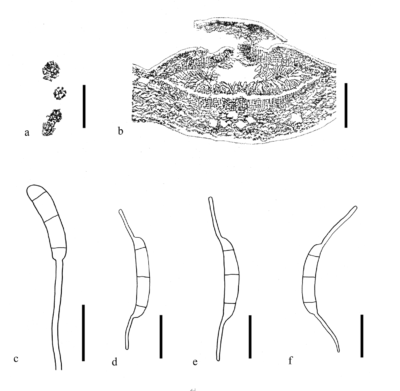Fungalpedia – Notes 235, Immersidiscosia
Immersidiscosia Kaz. Tanaka, Okane & Hosoya
Index Fungorum, Facesoffungi, MycoBank, GenBank, Fig. 1
Citation when using this entry: Li et al. 2024 (in prep) – Fungalpedia, Xylariomycetidae.
Classification: Sporocadaceae, Amphisphaeriales, Xylariomycetidae, Sordariomycetes, Ascomycota, Fungi.
Immersidiscosia, a coelomycetous genus, was established by Tanaka et al. (2011) with I. eucalypti as the type species based on morphological and phylogenetic analyses of combined SSU, LSU, ITS, and tub sequence data. It was reported as saprobe isolated from dead leaves of Laurus nobilis (Lauraceae) in France, dead leaves of Ardisia japonica (Primulaceae) and Quercus myrsinifolia (Fagaceae) in Japan and dead leaves of Eucalyptus sp. (Myrtaceae) in Tunisia (Tanaka et al. 2011). This genus is characterized by deeply immersed, scattered, unilocular, pycnidial conidiomata that are intraepidermal to subepidermal in origin, with a conidiomatal beak having periphyses and cylindrical, 3-septate, hyaline, with an appendage at both ends (Tanaka et al. 2011). Immersidiscosia is similar to Discosia in having cylindrical, branched conidiophores; cylindrical, holoblastic, hyaline, smooth conidiogenous cells; and cylindrical, 3-septate, hyaline conidia with an appendage at both ends. However, it differs from Discosia by having deeply immersed pycnidia (intraepidermal to subepidermal in origin) and a developed beak or opening with hyaline periphyses. Only one species is listed under Immersidiscosia in Species Fungorum (2024).
The classification of Immersidiscosia has undergone several reclassifications since its establishment in Amphisphaeriaceae, Amphisphaeriales, Xylariomycetidae, Sordariomycetes (Tanaka et al. 2011). Maharachchikumbura et al. (2015) supported Immersidiscosia in Amphisphaeriaceae based on combined LSU, SSU, tef1 and rpb2 sequences, which is congruent with the study proposed by Tanaka et al. (2011). Senanayake et al. (2015) introduced a new family Discosiaceae and included Immersidiscosia based on phylogenetic analyses of combined LSU and ITS sequence data. Later, Jaklitsch et al. (2016) demonstrated that Immersidiscosia grouped distinctly from Amphisphaeriaceae based on combined ITS and LSU sequences data. They considered Discosiaceae to be a synonym of Sporocadaceae. This classification was based on Wijayawardene et al. (2017, 2020, 2022), and Hyde et al. (2020). Considering the coelomycetous morphological characteristics of Immersidiscosia, which have an appendage consistent with the familial concept in Sporocadaceae (Liu et al. 2019) and based on the phylogenetic analysis provided by Jaklitsch et al. (2016), we accept Immersidiscosia in Sporocadaceae. However, the DNA sequence data for Immersidiscosia are currently only available for LSU and ITS in GenBank, awaiting additional genes to confirm the taxonomic placement of Immersidiscosia.
Type species: Immersidiscosia eucalypti (Pat.) Kaz. Tanaka, Okane & Hosoya (Basionym: Cryptostictis eucalypti Pat.)
Figure 1 – Immersidiscosia eucalypti (a FH holotype of Cryptostictis eucalypti. b, g HHUF 29923. c–d FH holotype of Cryptostictis eucalypti. f FH 1032). a Conidioma on the host surface. b Longitudinal section of conidiomata. c Conidiogenous cells. d–f Conidia. Scale bars: a = 1 mm, b= 100 µm, c–f = 10 µm. Redrawn from Tanaka et al. (2011).
Reference
Wijayawardene NN, Hyde KD, Dai DQ, Sánchez-García M et al. 2022 – Outline of
Fungi and fungus-like taxa – 2021. Mycosphere 13, 53–453.
Entry by
Yanxia Li and Mingkwan Doilom, Innovative Institute for Plant Health/ Key Laboratory of Green Prevention and Control on Fruits and Vegetables in South China, Ministry of Agriculture and Rural Affairs, Zhongkai University of Agriculture and Engineering, Guangzhou, 510225, China.
(Edited by Kevin D. Hyde, Samaneh Chaharmiri-Dokhaharani, & Achala R. Rathnayaka)
Published online 19 April 2024
